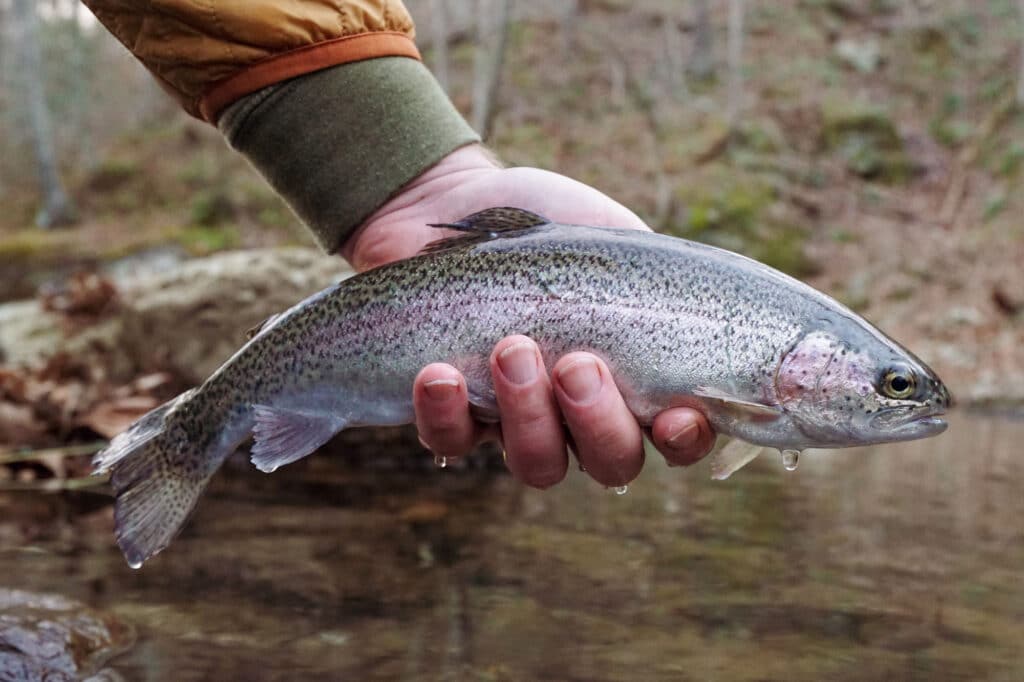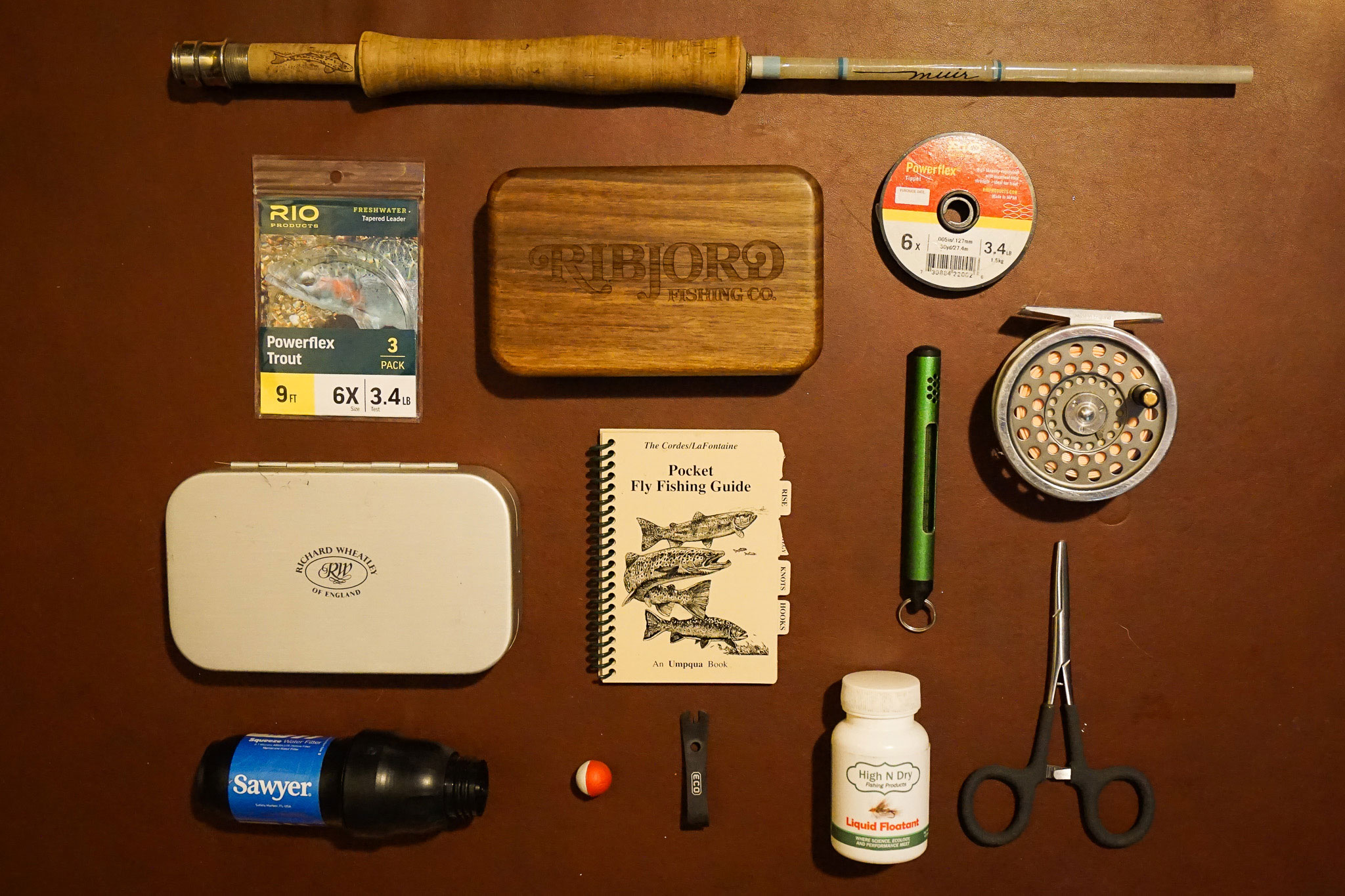Becoming a fly angler takes time, but the effort is worth it. In its purest form, fly fishing is a passage to serenity, an escape to stand amongst the slow drip of seasonal change and watch the sun bow over the ridgeline. The beauty of fly fishing is that the rewards are endless. As you keep casting, you gain a deeper understanding of a cycling environment.
“Be open and be patient,” offers Wesley Hodges, guide and owner of Wesley Hodges Fly Fishing, a sporting lodge and outfit in Eagle Rock, Va. “If you’re going to learn to fly fish, be a sponge to everything around you.”
At first, you’ll begin to master your local pond or river and its keepers. But then there is another pool just beyond the bend that houses a stout chunker below the log with a tendency to swallow up sinking flies. Your next outing might be the day you two finally meet.

What You’ll Need
The breadth of a fly angler’s gear will inevitably evolve over a lifetime. You start with the bare bones because you’re skeptical that the sport is worth your time. Cost isn’t neglible, so you may hold off on all the accoutrements. But after a promising trip or two and a way-too-long conversation at the fly shop, you’ll give in.
Your pack can quickly inflate with seven tippet spools, three different styles of indicator, floatant liquid, floatant powder, floatant gel, floatant beads, a few fly boxes that were originally categorized by dry flies, nymphs, and streamers. Eventually it all bleeds together to make a tangled dry-dropper hodgepodge.
If you’re fishing on foot, stay light if you can—a pair of nippers, a tin of intentional flies, some liquid floatant (you can use your shirttail to replace powder), and some 6x tippet will do just fine.
The Rod & Reel
If you plan on fishing for several species with the same rod, a 5wt is a great start. It’s light enough to have fun fishing small mountains while still having enough backbone for bigger trout and bass.
Like most things in fly fishing, there is wiggle room. Some of the most fun I’ve found is a jumping rainbow trout on a 3wt fiberglass rod. It takes delicate maneuvering on the retrieve, but I’d never suggest not going for a trip because you’re on the edge of a suggested correct weight for your endeavor.

The Vice
One of the more prolific fibs of fly fishing is that you save money by tying your own flies. That may be true for those tying hundreds, but it’s quite the stretch for the working angler. But that doesn’t mean that tying your own isn’t worth it.
“It’s another level of becoming intimate in the sport, a reminder that the small details matter,” says Hodges. “It gives a strong conviction that what you’re doing is right.”
Tying adds another layer to understanding the intricacies of fish food. As the Blue Ridge goes, master a black wolly bugger, Mr. Rapidan dry fly, and a zebra midge. With those in your pocket, you can cover just about all the water you can find.
Scoping Out a Spot
Become a champion of your locality. Ask questions at your local fly shop. Start with understanding your area, what is wild, and what is native. If you’re at elevation, there could very well be native brook trout within a drive, or maybe there’s a section of reproducing brown trout in a spring creek, structured rivers housing smallmouth, or ponds full of pumpkinseed, red-breasted, and longear sunfish.
Check out your local DNR website for fishing access. You could stumble upon anything from a kayak put-in to a walk-and-wade trailhead. Most areas have published literature on their fishing rivers by now, so thumb through them to learn from folks who have already done the hard work. If you want to get into the good spots, hike or float farther than most are willing, and you’ll have the whole world at your fingertips.
“Graduate your trips as needed. Putting a lot of emphasis on really unique destinations can be overwhelming as a beginner,” Hodges adds, referring to trips abroad. “Don’t de-value what you have local; otherwise, you’re missing a lot that fly fishing has to offer.”
Hiring a guide for the day could be worthwhile to expedite a new angler’s learning curve, especially in a particular watershed. The right guide will teach layers of how to read the water, specific tactics for targeted species, and which stretch of the day is best spent taking a long lunch until the hatch starts back up.

Some Guiding Principles
Conservation ethics are paramount: keep fish in the water as much as possible, use barbless hooks, pass on fishing water too hot for its inhabitants, and support regulation that preserves wild places.
The most rewarding landings of the fly fishing community aren’t about your brand of waders, if you swear by the prince nymph or are a dry fly purist, or whether you’ve jumped a hundred tarpon or pop pond bugs over big mouth bass fry nests. The spool that ties us all together is the pursuit to preserve the resource and a bit of ourselves.
Cover photo: A look inside a trout guide’s fishing pack. All photos by the author







